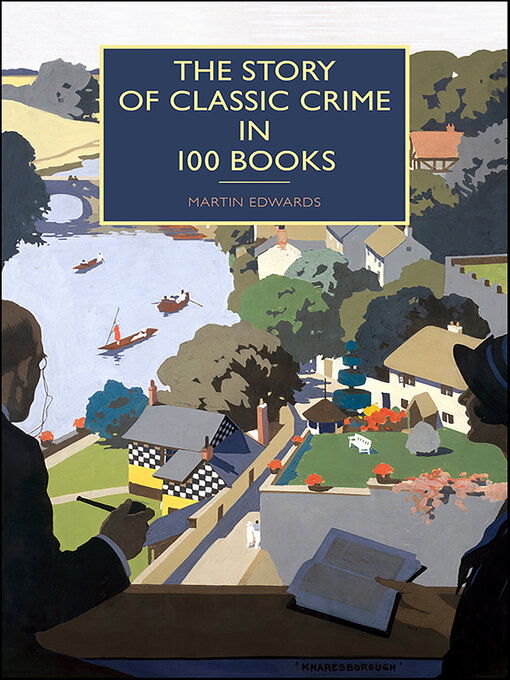“This is an exemplary reference book sure to lead readers to gems of mystery and detective fiction.” —Publishers Weekly, starred review
This book tells the story of crime fiction published during the first half of the twentieth century. The diversity of this much-loved genre is breathtaking, and so much greater than many critics have suggested. To illustrate this, the leading expert on classic crime discusses one hundred books ranging from The Hound of the Baskervilles to Strangers on a Train which highlight the entertaining plots, the literary achievements, and the social significance of vintage crime fiction. This book serves as a companion to the acclaimed British Library Crime Classics series but it tells a very diverse story. It presents the development of crime fiction—from Sherlock Holmes to the end of the golden age—in an accessible, informative and engaging style.
Readers who enjoy classic crime will make fascinating discoveries and learn about forgotten gems as well as bestselling authors. Even the most widely read connoisseurs will find books (and trivia) with which they are unfamiliar—as well as unexpected choices to debate. Classic crime is a richly varied and deeply pleasurable genre that is enjoying a world-wide renaissance as dozens of neglected novels and stories are resurrected for modern readers to enjoy. The overriding aim of this book is to provide a launch point that enables readers to embark on their own voyages of discovery.
-
Creators
-
Publisher
-
Release date
April 2, 2024 -
Formats
-
Kindle Book
-
OverDrive Read
- ISBN: 9781464207242
- File size: 17870 KB
-
EPUB ebook
- ISBN: 9781464207242
- File size: 15669 KB
-
Open EPUB ebook
- ISBN: 9781464207242
- File size: 15097 KB
-
-
Languages
- English
-
Reviews
-
Publisher's Weekly
Starred review from April 17, 2017
Written as a companion to the British Library’s Crime Classics series of reprints, this descriptive critical catalogue of 100 crime and mystery novels (mostly British) published in the first half of the 20th century is irresistible for aficionados and a reliable reading list for newcomers. Edwards’ picks, most published during detective fiction’s golden age between the two world wars, range chronologically from Doyle’s The Hound of the Baskervilles (1902) to Julian Symons’s The 31st of February (1950) and include, in addition to many of the usual suspects, a few outliers sure to enliven debates among diehard fans. He groups his selections into 24 chapters that cover numerous aspects of the literature—the great detectives, the fair-play mystery (epitomized by Ronald Knox’s The Body in the Silo), the miraculous or locked-room mystery (a specialty of John Dickson Carr), country house and manor murder mysteries, and so on—and whose ordering shows classic tropes giving way to newer approaches more resonant with modern times. A crime novelist in his own right, Edwards (The Golden Age of Murder) brings a specialist’s discerning eye to discussions of each book’s significance, and without giving away key plot points. This is an exemplary reference book sure to lead readers to gems of mystery and detective fiction. -
Kirkus
June 1, 2017
An "unashamedly idiosyncratic" checklist from prolific novelist/editor/genre historian Edwards (The Dungeon House, 2015, etc.).As readers will expect from the editor of the British Library Crime Classics series, the lion's share of these 100 brief program notes, which read like a collection of prefaces, concern mystery novels published in England between the world wars. In addition to dozens of inescapably obvious titles from The Hound of the Baskervilles to Strangers on a Train, Edwards, determined to share "new discoveries" even with the most well-read fans of the genre, includes warmly appreciative, brief essays on neglected classics like Roy Horniman's Israel Rank, Bernard Capes' The Skeleton Key, C.H.B. Kitchin's Birthday Party, Milward Kennedy's Death to the Rescue, and Sebastian Farr's Death on the Down Beat. Although the scenic, thematic organization of chapters like "Murder at the Manor," "Playing Politics," and "Fiction from Fact" makes the book read more like geography than history and often seems to dictate odd choices--e.g., Michael Innes' Death at the President's Lodging instead of his much better known Hamlet, Revenge! or Lament for a Maker--the coverage is impressive. Of the major golden-age British writers, only Georgette Heyer is notably absent, and even she makes a cameo as the model for a fictional character. Devoted American readers may wonder why Dashiell Hammett's The Dain Curse made the cut but not Mary Roberts Rinehart or the "wildly popular" Philo Vance novels by S.S. Van Dine, which hew much more closely to golden-age models. The quality of individual commentaries naturally varies, but for every pedestrian plod like the entry for J.S. Fletcher's The Middle Temple Murder, there are three sharp evocations like those of A.A. Milne's The Red House Mystery, Rupert Penny's She Had to Have Gas, and Helen Simpson's Vantage Striker. Even the most quarrelsome readers, their blood pressures duly raised, will take comfort in comprehensive indexes that list titles and authors that didn't make the top 100.COPYRIGHT(2017) Kirkus Reviews, ALL RIGHTS RESERVED.
-
Formats
- Kindle Book
- OverDrive Read
- EPUB ebook
- Open EPUB ebook
subjects
Languages
- English
Loading
Why is availability limited?
×Availability can change throughout the month based on the library's budget. You can still place a hold on the title, and your hold will be automatically filled as soon as the title is available again.
The Kindle Book format for this title is not supported on:
×Read-along ebook
×The OverDrive Read format of this ebook has professional narration that plays while you read in your browser. Learn more here.


